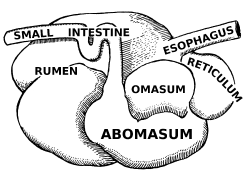Difference between revisions of "Ruminant" - New World Encyclopedia
Rick Swarts (talk | contribs) |
Rick Swarts (talk | contribs) |
||
| Line 20: | Line 20: | ||
A '''ruminant''' is an even-toed, hooved [[mammal]] of the order [[Artiodactyla]] that digests its plant-based food in two steps, first by softening it within the animal's first stomach, known as the [[rumen]], then regurgitating the semi-digested mass, now known as [[cud]], and chewing it again. The process of again chewing the cud to further break down plant matter and stimulate digestion is called "ruminating." Ruminating mammals include [[cattle]], [[goat]]s, [[sheep]], [[giraffe]]s, [[American Bison]], [[Wisent|European bison]], [[yak]]s, [[Bubalus|water buffalo]], [[deer]], [[camel]]s, [[alpaca]]s, [[llama]]s, [[wildebeest]], [[antelope]], [[pronghorn]], and [[nilgai]]. Taxonomically, the suborder [[Ruminantia]] includes all those species except the camelids (camels, llamas, alpacas, etc.) which are [[Tylopoda]]. Therefore, the term 'ruminant' is not synonymous with [[Ruminantia]]. | A '''ruminant''' is an even-toed, hooved [[mammal]] of the order [[Artiodactyla]] that digests its plant-based food in two steps, first by softening it within the animal's first stomach, known as the [[rumen]], then regurgitating the semi-digested mass, now known as [[cud]], and chewing it again. The process of again chewing the cud to further break down plant matter and stimulate digestion is called "ruminating." Ruminating mammals include [[cattle]], [[goat]]s, [[sheep]], [[giraffe]]s, [[American Bison]], [[Wisent|European bison]], [[yak]]s, [[Bubalus|water buffalo]], [[deer]], [[camel]]s, [[alpaca]]s, [[llama]]s, [[wildebeest]], [[antelope]], [[pronghorn]], and [[nilgai]]. Taxonomically, the suborder [[Ruminantia]] includes all those species except the camelids (camels, llamas, alpacas, etc.) which are [[Tylopoda]]. Therefore, the term 'ruminant' is not synonymous with [[Ruminantia]]. | ||
| − | + | Camelidae | |
==Explanation== | ==Explanation== | ||
Revision as of 15:10, 24 December 2008
| Ruminants | ||||||||
|---|---|---|---|---|---|---|---|---|
 Rough illustration of a ruminant digestive system
| ||||||||
| Scientific classification | ||||||||
| ||||||||
|
Antilocapridae |
A ruminant is an even-toed, hooved mammal of the order Artiodactyla that digests its plant-based food in two steps, first by softening it within the animal's first stomach, known as the rumen, then regurgitating the semi-digested mass, now known as cud, and chewing it again. The process of again chewing the cud to further break down plant matter and stimulate digestion is called "ruminating." Ruminating mammals include cattle, goats, sheep, giraffes, American Bison, European bison, yaks, water buffalo, deer, camels, alpacas, llamas, wildebeest, antelope, pronghorn, and nilgai. Taxonomically, the suborder Ruminantia includes all those species except the camelids (camels, llamas, alpacas, etc.) which are Tylopoda. Therefore, the term 'ruminant' is not synonymous with Ruminantia.
Camelidae
Explanation
Ruminants have a fore-stomach with four chambers. These are the rumen, reticulum, omasum, and abomasum. In the first two chambers, the rumen and the reticulum, the food is mixed with saliva and separates into layers of solid and liquid material. Solids clump together to form the cud (or bolus). The cud is then regurgitated, chewed slowly to completely mix it with saliva and to break down the particle size. Fiber, especially cellulose and hemi-cellulose, is primarily broken down into the three volatile fatty acids, acetic acid, propionic acid and butyric acid in these chambers by microbes (bacteria, protozoa, and fungi). Protein and non-structural carbohydrate (pectin, sugars, starches) are also fermented.
Even though the rumen and reticulum have different names they represent the same functional space as digesta can move back and forth between them. Together these chambers are called the reticulorumen. The degraded digesta, which is now in the lower liquid part of the reticulorumen, then passes into the next chamber, the omasum, where water and many of the inorganic mineral elements are absorbed into the blood stream. After this the digesta is moved to the last chamber, the abomasum. The abomasum is the direct equivalent of the monogastric stomach (for example that of the human or pig), and digesta is digested here in much the same way. Digesta is finally moved into the small intestine, where the digestion and absorption of nutrients occurs. Microbes produced in the reticulo-rumen are also digested in the small intestine. Fermentation continues in the large intestine in the same way as in the reticulorumen.
Almost all the glucose produced by the breaking down of cellulose and hemicellulose is used by microbes in the rumen, and as such ruminants usually absorb little glucose from the small intestine. Rather, ruminants' requirement for glucose (for brain function and lactation if appropriate) is made by the liver from propionate, one of the volatile fatty acids made in the rumen [citation needed].
Religious importance
In Abrahamic religions, a distinction between clean and unclean animals approximately falls according to whether the animal ruminates. The Law of Moses in the Bible allowed only the eating of animals that had split hooves and "that chew the cud" [1], a stipulation preserved to this day in the Kashrut. Some believe that the Koran considers a mammal halal only if it is ruminant. This is not true. See Dhabihah and Halal.
Other uses
The verb to ruminate has been extended metaphorically to mean to thoughtfully ponder or to meditate on some topic. Similarly, ideas may be chewed on or digested. Chew the (one's) cud is to reflect or meditate.
See also
- Monogastric
- Digestive Physiology of Herbivores - Colorado State University
ReferencesISBN links support NWE through referral fees
- ↑ Leviticus 11:6
Credits
New World Encyclopedia writers and editors rewrote and completed the Wikipedia article in accordance with New World Encyclopedia standards. This article abides by terms of the Creative Commons CC-by-sa 3.0 License (CC-by-sa), which may be used and disseminated with proper attribution. Credit is due under the terms of this license that can reference both the New World Encyclopedia contributors and the selfless volunteer contributors of the Wikimedia Foundation. To cite this article click here for a list of acceptable citing formats.The history of earlier contributions by wikipedians is accessible to researchers here:
The history of this article since it was imported to New World Encyclopedia:
Note: Some restrictions may apply to use of individual images which are separately licensed.